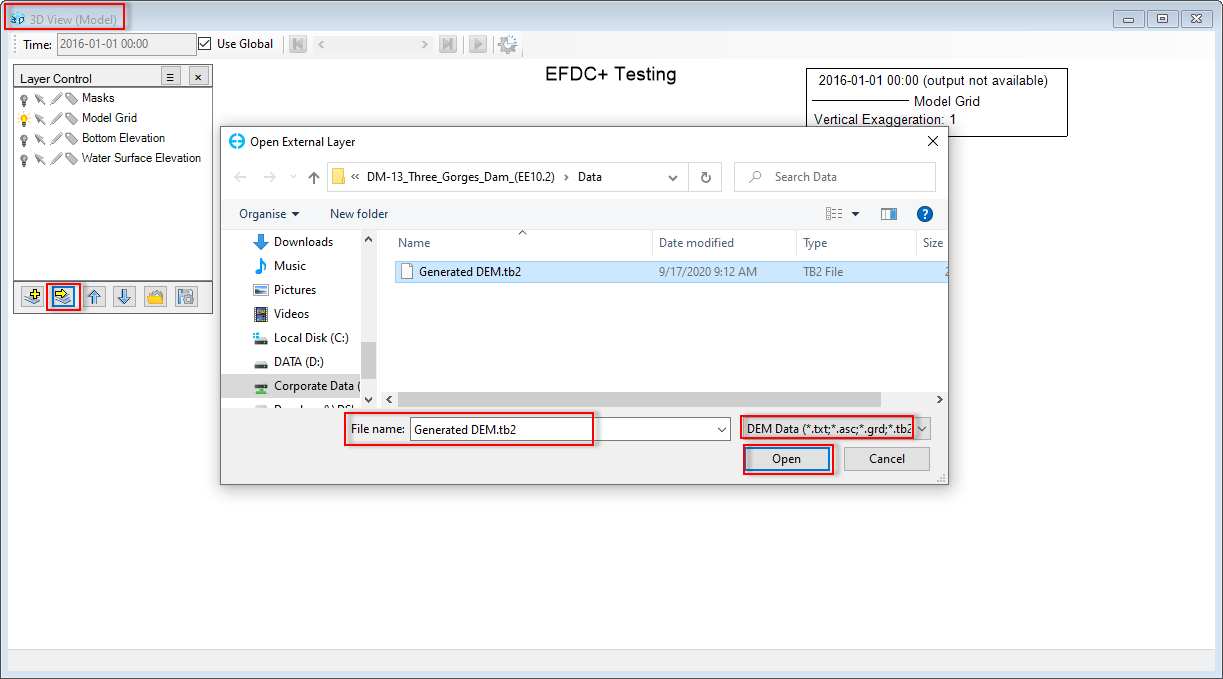EE can be used to generate and display a digital elevation model (DEM). This feature helps the viewer better understand the topography around the model domain and can be used to create realistic fly-throughs of an area of interest.
...
Generate DEM option can be accessed from several places as Layer Control in the 2DH View or in the 3D View or from the Tools menu as shown in Figure 1 and Figure 2.
| Anchor | ||||
|---|---|---|---|---|
|
Figure 1. Generate a DEM option from Layer Control in 2DH View.
...
Once the option is selected, the Generate DEM form will appear as shown in Figure 3. From this form, the user click on Add File then browse to the digital elevation data file (*.xyz). Once loaded, the coordinates of the Lower-Left and Upper-Right points will be updated as well as the Cell Size and Number of Cells, the user can change the Cell Size then click on the Calculator symbol to update the Number of Cells and vice versa. The more number of cells the higher resolution of the DEM file. There are three options for DEM file output format as TB2, ArcGIS ASCII Grid, and Surfer ASCII Grid. Select one from those options then click the Generate DEM button to start generating DEM file.
...
Once, the Generate DEM button is selected, the Export DEM form is displayed as shown in Figure 4. Enter a name in the File Name (e.g Generated DEM), select the folder directory to store the file then click Save button as shown in Figure 4. When DEM file generation has done, a an informing message will be popped up as shown in Figure 5. Click OK button to exit the form.
...
Open the 3D View, click the Import External Layer in the Layer Control. The Open External Layer form will be displayed. Select the DEM data file from the drop-down list next to the File Name box as shown in Figure 6. Select the DEM file then click Open button. The DEM layer will be added to the Layer Control and displayed as Figure 7.
Anchor Figure 6 Figure 6
Figure 6. Import DEM file.
...
The user can adjust vertical exaggeration to having a better view by changing the Vertical Scale Modifier in the form of 3D View Settings by RMC on the legend as shown in Figure 8. to set the DEM’s properties by RMC on this layer in the Layer Control, then select Properties option as shown in Figure 9..
Anchor Figure 8 Figure 8
Figure 8. 3D View Settings.
RMC the layer and select Properties option as shown in Figure 9, the user can edit the DEM layer.
Anchor Figure 9 Figure 9
Figure 9. DEM properties.
...
Figure 10. DEM properties.
Figure 10 shows DEM Layer Properties form. There are a number of options from this form as described below:
...
3D View Options frame
Flip North - South: turn over the layer into a different position
Sink with Current Model
Vertical Exaggeration: to adjust vertical scales.
...
This option allows to use geo-referenced map (e.g Google satellite image) to cover the surface of the DEM. Checked on box then click Browse button to browse to the geo-referenced image as shown in Figure 11 then click Open button and result is shown in Figure 12.
DEM Info: display general information of the DEM file as DEM size, cell size, X, Y, and Z range.
The Convert Height allows to convert the height of the DEM from the current unit (e.g meter) to other unit units (e.g foot). When this option is selected, the DEM Height Conversion form will appear as shown in Figure 13. Click the Convert button on this form then click the OK in the Figure 10 to implement the conversion. The new color ramp range for DEM will be updated on the legend.
...


.png?version=1&modificationDate=1606988299533&cacheVersion=1&api=v2)
.png?version=1&modificationDate=1606988651422&cacheVersion=1&api=v2)